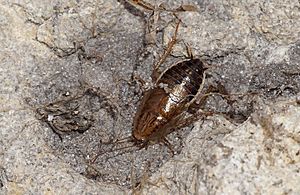Least yellow cockroach facts for kids
Quick facts for kids Least yellow cockroach |
|
|---|---|
 |
|
| Scientific classification | |
| Genus: |
Cariblatta
|
| Species: |
minima
|
The Cariblatta minima, also known as the least yellow cockroach, is a small insect. It belongs to the cockroach family called Ectobiidae. You can find this tiny creature in parts of North America and the Caribbean islands.
Contents
Discovering the Least Yellow Cockroach
The least yellow cockroach is a fascinating insect, even though it's quite small. It was first officially described in 1916 by a scientist named Morgan Hebard. This species is part of a larger group of cockroaches. These insects have been around for millions of years.
What Does It Look Like?
The least yellow cockroach is, as its name suggests, quite small. It has a yellowish-brown color. Like other cockroaches, it has a flattened body. This shape helps it squeeze into tight spaces. It also has two long antennae on its head. These antennae help it feel and smell its surroundings.
Where Does It Live?
This cockroach prefers warm, humid places. Its natural home includes regions in North America, especially the southern parts. It also lives across many islands in the Caribbean. These areas provide the perfect environment for it to thrive. It often lives outdoors in leaf litter or under bark.
What Does It Eat?
Like many cockroaches, the least yellow cockroach is an omnivore. This means it eats both plants and animals. It likely feeds on decaying plant matter. It might also eat tiny bits of dead insects. This helps clean up its environment.
Life Cycle of the Least Yellow Cockroach
The life cycle of the least yellow cockroach is similar to other insects. It goes through several stages. Understanding these stages helps us learn more about its biology.
Reproduction
Female cockroaches lay their eggs in a special case. This case is called an ootheca. The ootheca protects the eggs. After a period, tiny nymphs hatch from these eggs. These nymphs look like small versions of the adult cockroach.
Growth and Development
The nymphs grow by shedding their outer skin. This process is called molting. They molt several times as they get bigger. Each time they molt, they get closer to becoming an adult. Once they reach their final molt, they are fully grown adults. They can then reproduce and start the cycle again.
Importance in Nature
Even small insects like the least yellow cockroach play a role in their ecosystem. They help break down decaying matter. This process returns nutrients to the soil. This is important for plant growth. They can also be a food source for other animals. These might include birds, lizards, or spiders.
See also
 In Spanish: Cariblatta minima para niños
In Spanish: Cariblatta minima para niños

